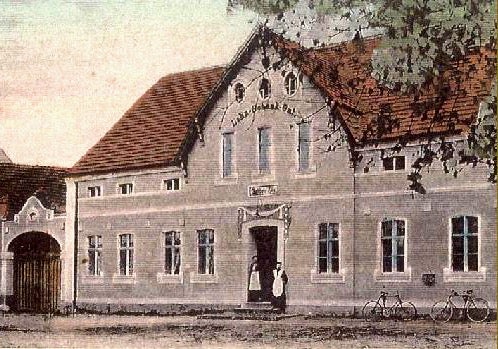The Location
A former feudal tavern estate
First mentioned in the 14th century, this property is located on the village square of Werenzhain, on the edge of the Lausitzer Heathland Nature Park in the Elbe-Elster district in Lower Lusatia.
After a varied history, this protected historic former feudal tavern estate has been a home for artists and creative individuals since 1996.x In addition to rotating exhibitions, it hosts summer workshops, art education, and workshops. Barns, stables, and outdoor areas are available for artistic work.
The Werenzhain Atelier Courtyard comprises a main building with a stage hall, gallery, shop, and a café, covering an area of approximately 7,000 square meters. It also includes former barns and stables, as well as a fully functional bakehouse. Accommodation options are available in the adjacent guesthouse.
The grounds, with its tranquil, ever-changing ambiance amidst meadows, fields, and small forests, provide an ideal setting for artists to engage in intensive work and stimulating interactions.
The enclosed inner courtyard encourages concentration, while the expansive horizon opens up the view and the soul. Spacious barn passages with a view of pastures and fields are suitable for celebrations, workshops, and seminars.



History of the Courtyard
Since 1996, the former feudal tavern estate has been listed as a historical monument.
Due to its prominent location, size, and distinct facades that set it apart from the surrounding historic farmsteads, it shapes the center of the roadside village (urban significance). Additionally, the property holds local historical importance as the centuries-old residence of the Werenzhain village bailiffs and mayors.
Its significance in agricultural history stems from the combination of an inn with a banquet hall and a relatively large agricultural operation, even by Werenzhain standards. The diversity of the various buildings reflects the multifaceted approach of such an establishment. Furthermore, the buildings, with their facilities geared toward different livestock housing, as well as the additional use of the outbuildings as servant quarters and the large bakehouse, serve as testimonies to rural construction around 1900 and, therefore, have ethnographic significance.
For visitors, much of the estate remains in its original state and possesses a unique charm. It is essential to preserve this through gentle restoration for the future.
The location of Werenzhain was first documented in 1234 when it was handed over to the Dobrilugk Monastery under the names “Witheroldeshagen” or “Wetheroldeshagyn.” Just like the neighboring church constructed from granite blocks, the courtyard was part of the core of the original monastery village.
Since 1996, the former feudal tavern estate in Werenzhain has been owned by the Art Association. The four-sided courtyard includes numerous outbuildings in addition to the main building with the banquet hall. These comprise stables and barns, as well as servant and bakehouses. The complex is located on the village square, in direct proximity to the village church, which dates back to 1250.

In the past...
From 1674 onwards, Werenzhain had its own village regulations, along with its own village bailiff (later mayor), whose estate was located where the present-day Atelier Courtyard stands. Both the office of the feudal judge and the operation as an estate and tavern were hereditary.
The old building underwent several renovations and alterations and fell victim to two fires, first in 1754 and then again in 1884.
In 1889, the courtyard was rebuilt, initially as a pure brick construction, like all other farms in the village. In 1907, the facade was plastered and adorned with architectural ornamentation in the contemporary style.
The Klixhof, named after its owner Hulda Klix starting in 1888, became a popular and frequently visited destination, especially during the early 20th century with the rise of the nature and hiking movement. She reserved the “blue room” in the gable of the house exclusively for travelers. Due to the expansion of railroads, the region around Doberlug-Kirchhain became part of the travel and vacation routes connecting major cities like Berlin, Leipzig, and Dresden.
The family-run business thrived through generations. After World War II, the courtyard came under the ownership of the LPG Werenzhain.
Günther Klix continued to operate the pub until the 1970s, now as a consumer cooperative pub. The inn, with its large banquet hall and stage, was well-known in the region as a venue for all sorts of celebrations and events.

... and today
In the early 1990s, following the reunification, various tenants and innkeepers made little contribution to the preservation or restoration of the building complex.
With the property’s return and inheritance, the Nitzschke brothers, Bernd and Frank, became the owners of the courtyard. ernd Nitzschke and his wife Ursula Cremer felt a strong connection to the place of his childhood and shared an interest in art and regional culture. In their search for partners in the cultural field, Ursula Cremer found dedicated collaborators within an artists’ group from Berlin and Brandenburg.
In November 1996, the Atelierhof Werenzhain e.V. association was founded, and the spaces of the former pub were transformed into gallery spaces for exhibitions and projects with great dedication.
Since then, the courtyard has presented itself as a vibrant place where numerous projects have been realized, and a lively exchange takes place.

